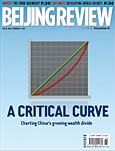 | | What's the Real Income Gap | | China's Gini coefficient reached its highest level in 2008, standing at 0.491, but began to drop after that. In 2012, the coefficient reached 0.474.
After the 2008 global financial crisis, local governments at various levels adopted powerful measures to improve people's livelihood, which serves as the major reason for the drop in the country's Gini coefficient from 0.491 | | Full Story | |
|
|
|
|
|
|
|
| Gini Coefficient | | The Gini coefficient measures income inequality. It is a number between 0 and 1, where 0 corresponds to perfect income equality, and 1 to perfect inequality. The internationally recognized warning line of income inequality is 0.4. The higher the Gini coefficient, the greater the inequality. | | |
|
